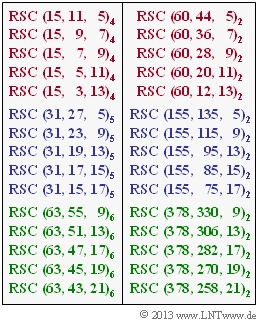Exercise 2.09: Reed–Solomon Parameters
Adjacent is an incomplete list of possible Reed–Solomon codes known to be based on a Galois field GF(q)=GF(2m).
The parameter m specifies with how many bits a Reed–Solomon code symbol is represented. It is valid:
- m=4 (red font),
- m=5 (blue font),
- m=6 (green font).
A Reed–Solomon code is generally denoted as follows: RSC (n, k, dmin)q.
The parameters have the following meaning:
- The parameter n specifies the number of symbols of a code word c_ ⇒ length of the code.
- Tthe parameter k specifies the number of symbols of an information block u_ ⇒ dimension of the code.
- The parameter dmin denotes the minimum distance between two code words
(for all Reed–Solomon codes equal n−k+1). - The parameter q gives an indication of the use of the Galois field GF(q).
To the right, there is the binary representation of the same code:
- In this realization of a Reed–Solomon code, each information and code symbol is represented by m bits.
- For example, it can be seen from the first row that the minimum distance in terms of bits is also dmin=5 if in GF(2m) the minimum distance is dmin=5.
- This code can correct up to t=2 bit errors (or symbol errors) and detect up to e=4 bit errors (or symbol errors).
Hints:
- This exercise belongs to the chapter "Definition and Properties of Reed-Solomon Codes".
- However, reference is also made to the chapter "Extension Field".
Questions
Solution
- n=q−1=2m−1⇒m=4:n=15_,m=5:n=31_,m=6:n=63_.
(2) To be able to correct t symbol errors, the minimum distance must be dmin=2t+1.
- The Reed–Solomon code is a so-called "Maximum Distance Separable (MDS) code".
- For this applies:
- dmin=n−k+1=2t+1⇒k=n−2t=2m−(2t+1).
- This gives for the
- RSC 1 (with m=4, t=4):k=24−(2⋅4+1) =7_,
- RSC 2 (with m=5, t=8):k=25−(2⋅8+1) =15_.
(3) The denotation of a Reed–Solomon code is RSC(n,k,dmin)q with q=2m=n+1.
- Correct are the solutions 1 and 4:
- RSC 1⇒RSC(15,7,9)16,
- RSC 2⇒RSC(31,15,17)32.
(4) If dmin denotes the minimum distance of a block code, it can be used to detect e=dmin−1 symbol errors and to correct t=e/2 symbol errors:
- RSC 1:dmin= 9, t=4, e=8_,
- RSC 2:dmin=17, t=8, e=16_.
(5) Correct are the two middle solutions 2 and 3:
- For RSC 1(m=4): n=15 code symbols from GF(25) correspond to 60 bits and k=7 information symbols are exactly 28 bits:
- RSC 1⇒RSC(15,7,9)16⇒RSC(60,28,9)2,
- RSC 2⇒RSC(31,15,17)32⇒RSC(155,75,17)2.
- For the minimum distance on bit level ⇒ GF(2), dmin=9 resp. dmin=17 result in the same values as on symbol level (see "theory section").
